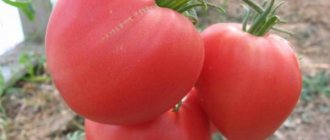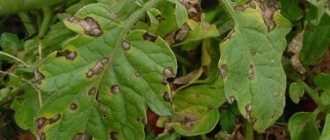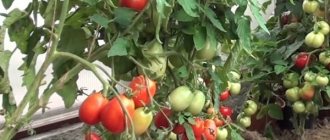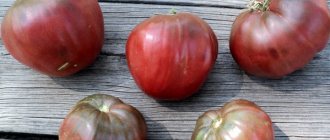Description of tomato Golden Eggs
The Golden Eggs tomato is an early-ripening determinate variety. Unlike other varieties, Golden Egg tomatoes finish growing on 4-6 bunches. The brushes of the Golden Egg variety are formed after the 5th leaf, then after each pair of inflorescences.
In southern areas, such tomatoes are grown in an open garden; in cooler areas, they prefer to grow them in a greenhouse. When planted in greenhouses, the plant quickly gains growth and sometimes needs staking.
The stem height of the Golden Eggs tomato is from 25 to 45 cm. The leaves are medium-sized and of regular shape.
Description of fruits
The fruits of Golden Egg tomatoes are oblong, ovoid in shape. Color orange or yellow. The weight of one tomato is from 80 to 220 g. Tomatoes have thin but durable skin. The pulp is quite fleshy, sweet with a sour taste. Each tomato has from 6 to 12 nests.
De Barao orange, or Golden eggs in my tomato collection
De Barao orange July 18
The dream of any tomato lover: to have tasty, beautiful, early, long-bearing and pain-free tomatoes... Do you know many of these varieties? Everyone lacks something... I haven’t found the ideal yet, although I strive for it with all my heart. The De Barao series is very close to the desired ideal.
De Barao orange, Aelita company
These tomatoes are beautiful, tasty, good in jars, and bear fruit until November (or they could have done it longer, I just returned to the city and had to remove the bushes...) And most importantly, they didn’t get sick!!! And I was very pleased with the yield! They can be planted not only in a greenhouse, but also in a greenhouse, but I didn’t, because... My beds are high, and De Barao’s bushes grow up to 3 meters, what kind of supports are needed... I’m not even talking about the fact that I can’t reach it...
De Barao orange
Tomatoes are ovoid, smooth, dense, weighing about 65 - 80 g.
The longer they hang on the bushes, the more intense the color. And very tasty. I already made a salad from these De lambs in the city, in November:
But according to the description, they are not early... But you can “fight” with this - you can sow them in February... I planted my De lambs on February 5th (my hands were really itching...), they sprouted on February 12th. I decided that let them grow, then I’ll cut off the tops, put them in water and they won’t be so tall... But it didn’t work out... On April 15 I had to go to the dacha, and I took several seedlings with me. I think, anyway, in a month, I will break these De Barao during transportation. So I took them out so early, made deep holes in the greenhouse, put dry grass at the bottom, sprinkled them with earth, “salted” them with ash, and poured boiling water over them. And I planted them... I think that if they survive, they will be early, and if not, then I have plenty of other seedlings... But I placed 5-liter bottles of water nearby so that they would heat up during the day, and at night they would give the heat to my little lambs... They survived and actually began to bear fruit among the first. And so all summer... I don’t remember the exact date of the first ripe tomato, but this photo is from July 15, which means that by that time they were already bearing fruit in full... De Barao orange July 15 But in October I “launched” De Barao orange, did not plant and they turned the “tail” of my greenhouse into impenetrable jungle... True, when I cut out these wilds, I got a box with “golden eggs”...
The other varieties of De Barao were not so aggressive, but also very productive and tasty...
De Barao striped De Barao red
It’s not difficult to buy De Barao, everyone knows this variety, but many are scared off from planting by the fact that they grow very tall (3 meters), require garter and the fact that they are late-ripening, and in our area it is better to focus on early-ripening varieties... But De Barao is not sick, so, in my opinion, this balances out his late maturity...
De Barao orange from the seedspost website I also bought De Barao Giant from the site, because... I love experimenting and I love this series.
De Barao Giant Like all De Barao, it is fruitful, tasty, tall, late-ripening and suitable for whole-fruit canning...
Ads by
We recommend!
The online store Seedspost.ru invites you to familiarize yourself with the Vegetable Seeds catalog, where you can choose and purchase seeds of any vegetables you like, including tomatoes de Barao.
Characteristics of the variety
After looking at the photo and studying the description of the Golden Eggs tomato variety, we can come to the conclusion that this crop is not only profitable, but also not troublesome to grow in the garden. But before you start planting, it is important to study the characteristics of the variety in order to avoid common mistakes in cultivation and care.
Advice! It is recommended to purchase Golden Egg tomatoes from trusted summer residents or in a specialized store.
Productivity and fruiting
This variety has a high yield. From one Golden Egg tomato bush you can collect from 12 to 17 fruits, which is up to 2 kg of tomatoes from one small plant.
The variety is early ripening and has good seed germination. Gives a harvest 125 days after planting.
Area of application of fruits
Golden Egg tomatoes are versatile in use. The taste is excellent, which is why many summer residents love this variety. Tomatoes can be safely consumed fresh, especially for children. Due to the light pulp, the fruits are free of allergens. Such tomatoes are often used to prepare baby purees. Tomatoes are also suitable for preparing salads and other preserves. Due to their compact size, the fruits fit into any jar and look beautiful in assorted cans.
Resistance to diseases and pests
The Golden Eggs tomato variety has good immunity to fungal infections. However, it is important to ensure proper care. After all, even the most unpretentious plant, but in the absence of basic care rules, can be infected by a fungus or harmful insect.
Golden Eggs – variety of Tomato plant
Variety characteristics:
Properties of the Golden Eggs variety:
Recommended region on the map:
Information on the admission of Tomato Golden Eggs from the Register of the State Variety Commission of the Russian Federation
Application for admission No. 67071, registered 2015-04-21. The Tomato variety Golden Eggs is included in the register of those approved in 2015. Approved for use in regions: All regions.
The originator of the Tomato Golden Eggs variety is:
Information about the patent for the Tomato variety Golden Eggs
Patent holder of the Golden Eggs variety:
- DEDERKO VLADIMIR NIKOLAEVICH
Application for protection of the Golden Eggs variety No. 67072, registered 2015-04-21.
Patent No. 8317, registered 2016-03-16. Estimated patent expiration date 2046-12-31.
Authors of the Tomato variety Golden Eggs
- Dederko Vladimir Nikolaevich
Other varieties of tomato plant
Search for variety by name
Variety selection
Question to the portal experts
If you haven't found the answer to a question, don't hesitate to ask an expert.
Register or Login so you don't have to enter your Name and Email every time
Thanks for the comment! It will be published after checking by a moderator!
No comments yet, be the first!
A portal for those who love their dacha
Your question has been sent for moderation. Don't worry, we quickly check your questions and your question will be answered within 1 day.
We have noticed that you are already registered on our website. We recommend that you log in to view the question you created. If you don't remember your password, you can recover it.
You were not registered until today, so we have registered you. Your password has been sent to your specified mailbox.
Help our site develop!
Please read this message, it will not take up much of your time!
We so need your comments and questions to understand in which direction we should develop.
Don't forget to leave a comment if you found what you were looking for. And if you haven’t found it, use the “Ask an Expert” form in the site header. We will answer this question, and other visitors will be able to find the information that you could not find.
Sincerely, team of the portal Dacha-Dacha.ru
Your question has been sent for moderation. Don't worry, we quickly check your questions and your question will be answered within 1 day.
We have noticed that you are already registered on our website. We recommend that you log in to view the question you created. If you don't remember your password, you can recover it.
You were not registered until today, so we have registered you. Your password has been sent to your specified mailbox.
Advantages and disadvantages of the variety
The main advantages of the Golden Eggs tomato variety are:
- weather resistance;
- have strong immunity to insects and fungal diseases;
- high quality seeds - this variety provides 100% germination of seed;
- unpretentiousness in cultivation and care;
- the ability to grow in any conditions (greenhouse or open garden bed);
- good transportability, not afraid of mechanical damage;
- pleasant taste, suitable for fresh consumption;
- complete absence of allergens in the composition;
- affordable, sold at any garden store.
This variety has no disadvantages. Golden tomato fruits Eggs will not leave any summer resident indifferent.
Appearance and properties of fruits
Tomatoes of the Golden Eggs variety belong to the yellow-fruited tomatoes. At the stage of technical ripeness, the skin of the fruit acquires a golden-yellow hue. Tomatoes have a characteristic egg-shaped shape, as can be seen in the photo.
Despite the small size of the bushes, the first fruits in the cluster reach a weight of 200-220 g. The remaining tomatoes are approximately the same size, with an average weight of 100-150 g. Up to 15-17 fruits are formed on the bush.
The pulp of the Golden Eggs tomato is practically uncolored, pale yellow in color, and has a delicate consistency. The seed chambers are small. The skin is quite dense, the fruits are not prone to cracking, and are suitable for whole-fruit canning.
Excellent taste makes Golden Egg tomatoes a desirable vegetable on the summer table. The reduced acidity of the fruit, characteristic of all yellow tomatoes, makes it suitable for use in salads and other snacks. Tomatoes are pleasant to eat in their natural form. I have been growing this variety for several years because of its sweetish taste with a slight sourness. Children especially like yellow tomatoes.
Lightly colored tomato varieties have an important property - hypoallergenicity. Thanks to this, Golden Egg tomatoes are suitable for people prone to allergies, children and the elderly.
Growing rules
The crop is grown both in a greenhouse and in open ground. The planting location depends on the climate. Seeds are planted for seedlings in early March. Before planting, it is important to carry out preparatory measures with the soil and select the right containers.
Attention! When grown in a greenhouse, the Golden Eggs tomato bears fruit much better.
Planting seedlings
For planting, purchased soil mixture or soil from a summer cottage is suitable. The second is important to disinfect - heat it in the oven. Thus, all microbes are killed. It is also necessary that the soil is fertile and fertilized with humus.
Important! Any container for seedlings is suitable, the main thing is that it has drainage holes where excess liquid will drain.
Seed disinfection
In order for the seedlings to grow strong, it is important to disinfect the seed. This procedure is carried out by soaking the grains in a weak solution of potassium permanganate or with the addition of table salt. After soaking the seeds for half an hour in a disinfectant composition, you can begin planting.
Comment! Before planting, it is important to rinse the seeds with clean water.
Planting seedlings
Planting seedlings is carried out according to the standard scheme:
- prepare spacious boxes with drainage holes;
- fill the container with pre-disinfected soil;
- sow the seeds in slightly moistened soil and water well;
- cover the box with polyethylene and leave in a warm place until the first shoots appear.
Further care of the sprouts is carried out in compliance with the following rules:
- room temperature during the day – 20-25 degrees, at night – 15 degrees;
- regular watering and sufficient lighting (sometimes a light lamp is required);
- ventilation of places where sprouts develop (it is important not to create drafts).
Advice! It is better to moisten seedlings using a sprayer.
Picking
As soon as the seedlings appear, the seedlings are placed on the windowsill so that the plant receives a sufficient amount of sunlight. After 4-5 leaves appear on the sprouts, you can pick the seedlings.
Young tomato sprouts should be planted in separate plastic glasses, which should also have holes for drainage.
Hardening of seedlings
This procedure is performed closer to April. First, open the window for a couple of hours and take the sprouts out onto the balcony, gradually increasing the hardening time to a day. Thus, the culture will get used to sudden changes in temperature and will take root well in the new place.
Transfer
Tomatoes are planted in a permanent place closer to May. At the time of planting, the seedlings must have 6 leaves and be at least 25 cm in height.
As mentioned, Golden Egg tomatoes grow well both in a greenhouse and in an open garden bed. You can get more yield by planting tomatoes in a greenhouse. But if planting is carried out under the open sky, it is important to choose a place that will be well lit by the sun.
It is important to prepare the soil for planting tomatoes from last year. In the fall, the soil is dug up and fertilizing is applied. Humus, superphosphate and potassium salt will be excellent fertilizers. Closer to planting, the soil can be loosened a little.
Attention! It is important to observe crop rotation. It is recommended to plant tomatoes after cabbage, carrots and cucumbers.
Landing rules
To plant a Golden Egg tomato, you need to dig shallow holes and place the root of the plant there. 4 bushes are placed per 1 m2. Covering the roots with soil, the bushes are watered. After 10 days, you can apply the first fertilizing, the rest - as needed.
Features of cultivation
Early tomatoes, which include the Golden Eggs variety, can only be grown by seedlings. Before work, the seeds are treated with manganese and placed in the refrigerator for 48 hours, after wrapping them in a damp cloth. Laying in the ground is carried out in the first ten days of April.
Sequence of work:
- Wooden or plastic containers are filled with a nutrient substrate consisting of soil and compost in equal parts.
- Make grooves 1.5 cm deep at a distance of 4 cm.
- Seeds are placed at intervals of 1 cm.
- The soil surface is watered and the container is covered with film.
- When growth appears, the covering material is removed.
Planting material is grown at +15-17 0C in a lighted place - After the formation of the third leaf, the seedlings are planted.
The strongest sprouts are selected from the total mass and each is placed in a separate container.
Fertilizers are not needed for planting material; seedlings only need substrate. Water with warm water as the top layer of soil dries. Overwatering can be detrimental to tomatoes.
They are transferred to an open area in mid-June, to a greenhouse a week earlier:
- Make longitudinal furrows approximately 15 cm deep, cover the bottom with peat mixed with humus. Maintain 40 cm between furrows.
- Planting material is distributed at a distance of 30 cm, 5-7 plants are planted per 1 m2.
- Cover with soil up to the first leaves.
Picking seedlings into peat cups improves the survival process; the tomatoes are placed in the hole along with the container
- The bed is watered and mulched with straw.
Subsequent cultivation:
- Loosening is carried out superficially so as not to damage closely located roots. If the tree trunk circle is mulched, there is no need to dig up the soil.
- The emerging weeds are removed along with the root system.
- During drought, water the tomato 2 times a week with a small amount of water; sprinkling is not recommended during flowering.
- The Golden Eggs variety is fed with phosphate during the flowering period, and with potassium at the time of fruit set. Liquid organic fertilizers are applied at the root during the period of fruit ripening.
To prevent diseases, tomatoes are treated with copper sulfate during budding and when the fruits enter the milky ripeness phase.
Important! Nitrogen agents can be added after planting the Golden Eggs tomato; this should not be done in the future, since the bush will intensively grow green mass, not fruits.
Aftercare
The yield of the variety depends on the quality of care. Regular watering is a prerequisite. The crop does not require pinching; plants can be tied up if necessary.
Rules for soil moisture
Golden Egg tomatoes need to be watered 1-2 times every 10 days (the exact amount depends on the weather). If there is a drought outside, watering is carried out more often, when it is damp and raining outside, less often. However, before buds form, young bushes need to be moistened every 4 days. One plant requires 2 to 3 liters of settled water.
As soon as the bushes begin to actively grow, you should water less frequently, but more abundantly. But during the fruiting period, watering must be done moderately. Just 1.5-2 liters per bush, 2 times every 10 days will be enough.
Important! If the tomato tops begin to curl and turn yellow, this is the first signal that the plant does not have enough moisture.
Be sure to loosen the soil after each watering, do it very carefully so as not to harm the root system. Next, mulch with straw. In this way, you can maintain the required level of moisture much longer.
Fertilizer application
Tomatoes love organic or mineral fertilizers. In one season, plants are fed up to 4 times. The first application of fertilizer is carried out using slurry and watering the root of the plant. But when the bushes begin to form ovaries, you should fertilize them with phosphorus and potassium. This composition must be sprayed on the tops of the plant. All other treatments are carried out at intervals of 14 days.
Variety care
Fruiting of tomatoes depends on the supply of moisture and nutrients. According to reviews, Golden Egg tomatoes are unpretentious in care and do not require pinching. Low-growing bushes are tied at the top to a support.
Watering plants
Tomatoes are watered once or twice a week, taking into account weather conditions and their stage of development. The water is pre-settled in barrels and added in the morning or evening.
Watering scheme for Golden Egg tomatoes:
- before the formation of buds - every 3 days with 3 liters of water per bush;
- during the flowering period - 5 liters of water weekly;
- during fruiting - 2 liters of water twice a week.
A sign of a lack of moisture is yellowing and curling of the tops. With insufficient moisture, the inflorescences begin to fall off. Excess moisture slows down the development of tomatoes and provokes the development of diseases.
After watering, the soil is loosened to a depth of 5 cm so as not to damage the roots of the tomatoes. Mulching with peat or straw will help maintain soil moisture.
Fertilizer application
Tomatoes are fed with organic or mineral substances. During the season, 3-4 treatments are carried out.
For the first feeding, 0.5 liters of slurry is required. It is added to a 10-liter bucket of water, and the resulting solution is poured over the tomatoes at the root. The consumption of the product for each plant is 1 liter.
When the ovaries are formed, tomatoes are treated with a solution based on phosphorus and potassium. Phosphorus is responsible for the transport of nutrients in the plant body and the development of the root system. The final taste of tomatoes depends on potassium.
Advice! To feed tomatoes, take 30 g of superphosphate and potassium salt. The components are dissolved in 10 liters of water.
An effective way to feed is to spray the tomatoes on the leaves. To prepare a solution for foliar treatment, take components with phosphorus and potassium in an amount of 10 g each.
Between treatments of tomatoes there is a gap of 2-3 weeks. You can replace minerals with wood ash.
Protection from diseases and pests
According to the description, Golden Egg tomatoes remain resistant to major crop diseases. To protect plantings from late blight, they are treated with Ordan. Based on it, a solution is prepared, which is sprayed onto the plants leaf by leaf. Treatment is carried out every 10-14 days and stopped 20 days before harvesting.
When attacked by pests, the aboveground part of the tomatoes is damaged and the yield decreases. Insecticides are used against insects. Among the folk remedies, dusting with tobacco dust and watering with garlic and onion infusions are effective.
A variety with beautiful fruits - Golden Eggs tomato: description of tomatoes and their characteristics
To have golden eggs, you don’t have to have a Ryaba chicken. It is enough to plant a tomato with this name. This unique variety produces beautiful golden fruits with excellent taste. Farmers note in their reviews productivity, endurance and uncomplicated cultivation.
| Height | Landing location | Ripening time | Fruit color | Fruit size | Origin | Fruit shape |
| short | Greenhouse, Open ground | Early ripening | Yellow | Average | Variety | Plum-shaped or oval |
Description and characteristics of the variety
Tomato Golden Eggs is a determinate, low-growing variety. Plants grow compact, with strong and thick stems. They reach a height of 30-40 cm. 5-6 fruiting clusters are formed on the bushes, which are laid through 2 leaves. Each bunch produces 3-4 tomatoes.
Tomato Golden Eggs “Siberian Garden” is distinguished by high yields. The fruits have the following characteristics:
- the average weight varies in the range of 150-200 g;
- the shape is elongated and elongated, reminiscent of an egg;
- the pulp is fleshy, moderately juicy, sugary;
- the taste is sweetish with a gentle sourness;
- the skin is thin but durable.











